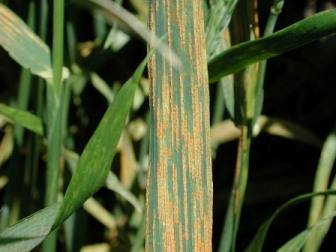Is Stripe Rust on the "Puccinia Pathway" to Manitoba?
Stripe rust, also known as yellow rust, is caused by the fungus Puccinia striiformis and can affect wheat, barley and triticale. Generally, wheat is more susceptible compared with barley and triticale.
In Manitoba, it has been detected sporadically since 2000. However, we have not seen serious yield losses to date, likely due to the fact stripe rust is favored by cooler weather, not our normal dry, hot weather.
What is the risk?
In Manitoba, rust does not overwinter. Instead urediniospores, the source of inoculum, are blown in on the “Puccinia Pathway” from the United States. Normally the first inoculum starts arriving at the beginning of June. However, this can vary depending on how much inoculum is present in the United States and when the winds blow from the south.
Often this migration of spores occurs during rainstorm events that pull air up from the south and deposits the rain, and the spores, here in Manitoba. During the growing season, reports on the current rust situation and how it is progressing in the United States are available in the Cereal Rust Bulletins from the United States Department of Agriculture (USDA).
There is also the potential for stripe rust to develop (if inoculum is present along with favorable weather conditions) since the varieties grown in Manitoba are generally susceptible, with some exceptions. Taking these factors into consideration, producers should start scouting their winter and spring wheat crops for symptoms of stripe rust.
Disease cycle and symptoms
Symptoms will normally appear about one week after infection. The urediniospores need several hours of moisture on plant leaves, along with temperatures near 10°C, to germinate and infect the host.
After infection, small yellowish uredinia appear in linear rows the length of the leaf blade as result of fungal mycelia from the spores elongating in parallel with the leaf veins (see figures).
A single infection can result in one stripe the length of the leaf. The head can also be infected and kernels are replaced with yellow spores. With severe early infections, plants can also be stunted.
The yellow stripes consist of rust pustules that contain numerous urediniospores (which were produced between eight days and two weeks after infection) that are ready to be dispersed for further infections.


Photos by: Dr. Brent McCallum, Agriculture and Agri-Food Canada
During the growing season, several crops of urediniospores can be reproduced and can continue to infect. Consequently, severe infections can progress from the middle to upper parts of the plant canopy resulting in yield reductions.
A single stripe rust infection on the leaf can take out the whole leaf without the need for another dew period, because it can grow internally, which is different than leaf or stem rust. Grain yield reduction is caused by the loss of green leaf area, affecting photosynthesis and grain fill.
Control
There are three main control methods:
- growing resistant varieties
- early seeding dates
- use of foliar fungicides
Later in the season, fungicides are the only control option left to Manitoba producers. The good news is wheat stripe rust can be managed by timely fungicide applications.
If the disease pressure, weather conditions and crop yield potential warrant application, foliar fungicides should be applied preventatively, before the disease is well-established in the crop, to provide maximum benefit. If disease severity (per cent of the leaf tissue infected on the plant) of stripe rust gets above 30 per cent, it is probably too late to save the crop.
There are numerous products available for the control of stripe rust. Refer to the Guide to Field Crop Protection for the most recent recommendations on the use of fungicides and a current list of registered fungicides. Always refer to product labels as they outline the crop and crop stage for application, recommended application rates, tank mix options, possible effects of weather, and restrictions (number of applications allowed per season, re-entry, re-cropping, pre-harvest interval, etc.).
One more important note is disease control should be the main reason in deciding to apply a fungicide. Application of fungicides in the absence of disease can help speed the development of fungicide resistance in some pathogens.
What about stem or leaf rusts?
Like stripe rust, leaf and stem rusts overwinters in the United States and are blown into Manitoba by winds. In the past, leaf rust in wheat has been more common in Manitoba than stem rust.
When scouting, look for small, round pustules that are bright orange-red in color on the upper surface of leaves and sheaths. As the plant matures, the pustules will darken and may appear black. Later in the season as the weather warms up, stripe rust will be less of concern while leaf rust will increase.
Sources
- K. Xi, T.K. Turkington, D. Salmon, B.D. McCallum and A. Navabi. Stripe Rust 101: What Is It, Why Do We Have It, What Can Be Done About It. Government of Alberta, Agriculture and Rural Development.
- Wheat Stripe Rust. United States Department of Agriculture, Agricultural Research Service
- Dr. Tom Fetch, Research Scientist – Cereal Stem Rust, Agriculture and Agri-Food Canada, Cereal Research Centre, Winnipeg, MB.
- Dr. Brent McCallum, Pathologist, Agriculture and Agri-Food Canada, Cereal Research Centre, Winnipeg, MB.
